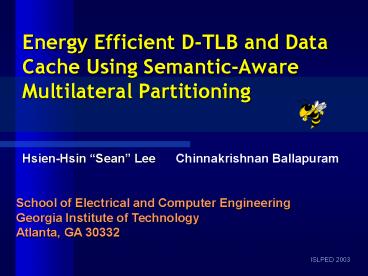Energy Efficient D-TLB and Data Cache Using Semantic-Aware Multilateral Partitioning - PowerPoint PPT Presentation
1 / 24
Title:
Energy Efficient D-TLB and Data Cache Using Semantic-Aware Multilateral Partitioning
Description:
Virtual Memory Space Partitioning. Based on programming language. Non-overlapped subdivisions ... Dj. Cj. Bc. Bf. bm. 23. ISLPED 2003. 24. ISLPED 2003. Design ... – PowerPoint PPT presentation
Number of Views:27
Avg rating:3.0/5.0
Title: Energy Efficient D-TLB and Data Cache Using Semantic-Aware Multilateral Partitioning
1
Energy Efficient D-TLB and Data Cache Using
Semantic-Aware Multilateral Partitioning
Hsien-Hsin Sean Lee Chinnakrishnan
Ballapuram
School of Electrical and Computer
Engineering Georgia Institute of
Technology Atlanta, GA 30332
ISLPED 2003
2
Background Picture
- Address Translation and Caches
- Major processor power contributors
- I-TLB and d-TLB lookup for every instruction
and memory reference - TLBs are Fully Associative
- Superscalar processor needs multi-ported design
increasing power consumption - multi-wide machines may need multiple memory
references in the same cycle
3
Virtual Memory Space Partitioning
- Based on programming language
- Non-overlapped subdivisions
- Split Code and Data ? I-Cache and
D-Cache - Split Data into Regions
- Stack (?)
- Heap (?)
- Global (static)
- Read-only (static)
- The unique access behavior to these regions by a
program creates an opportunity to reduce power
4
Outline of the Talk
- Motivation
- unique access behavior and locality are analyzed
for energy reduction - Semantic-Aware Multilateral Partitioning (SAM)
- Semantic-Aware d-TLB (SAT)
- Semantic-Aware d-Cachelets (SAC)
- Selective Multi-Porting SAM Architecture
- Performance/Energy/Area Evaluation
- Conclusions
5
Footprint of Stack Page Accesses
- Only two stack pages are required by all stack
accesses - ? stack band is small
- In general, x-axis shows the working set size,
y-axis shows the required TLB entries
6
Footprint of Global and Heap Page Accesses
- number of heap pages (y-axis) and heap working
set (x-axis) required is greater than stack and
global ? heap band gtgt global band gt stack band
7
Compulsory data-TLB misses
Number of compulsory TLB Misses
- highly active heap accesses evict the useful
stack and global entries due to conflict misses
8
Compulsory data-Cache misses
Number of compulsory Cache Misses
- smaller stack and global working set than heap ?
smaller stack and global cache size is enough to
capture most of the memory accesses to these
semantic regions
9
Dynamic Data Memory Distribution
- 40 of the dynamic memory accesses go to the
stack which is concentrated on only few pages - 4 memory accesses 2 stack, 1 global and 1 heap
10
Semantic-Aware Memory Architecture
Virtual address
Data Address Router
Most of the memory references go to
smaller stack and global TLB
smaller stack and global cache
? Reduced power consumption
To Processor
To Processor
hCache
gCache
sCache
sCache
Unified L2 Cache
11
Semantic-Aware TLB Misses
TLB Miss Rate
Number of TLB Misses
Number of TLB Entries
- The number of hTLB misses does not come down
even at 512 TLB entries
12
Semantic-Aware TLB Misses
TLB Miss Rate
Number of TLB Misses
Number of TLB Entries
- The number of gTLB misses saturate at 8 TLB
entries
13
Semantic-Aware TLB Misses
TLB Miss Rate
Number of TLB Misses
Number of TLB Entries
- The number of sTLB misses saturate faster than
global and heap
14
Semantic-Aware Cache Misses
Cache Miss Rate
Number of Cache Misses
Cache Size in KB
- Stack demonstrate very stable working set size
than the other two. Global saturates at a
reasonable rate.
15
Simulation Infrastructure
- Target Architecture ARM
- Performance Simplescalar
- Power Integrated Wattch Power Model
- Access Time/Area CACTI 3.0
Execution Engine Out-of-Order
Fetch / Decode / Issue / Commit 4 / 4 / 4 / 4
L1 / L2 / Memory Latency 1 / 6 / 150
TLB hit / miss latency 1 / 30
L1 Cache baseline DM 32KB
L1 stack / global / heap Cachelet 8KB / 8KB / 16 KB
L2 Cache 4w 512KB
Cache line size 32B
16
Design Effectiveness of SAM
Performance Ratio
d-TLB Energy w/ SAT
L1 d-Cache Energy w/ SAC
4 Perf. Loss
1.00
0.90
0.80
0.70
0.60
0.50
35 Energy Savings
0.40
0.30
0.20
0.10
0.00
fft
gcc
mcf
Avg
cpeg
djpeg
bzip2
parser
dijkstra
rijndael
patricia
bitcount
blowfish
17
Multi-porting Effectiveness of SAM
18
Multi-porting Access Time / Die Area
Baseline Semantic-Aware Cachelets (SAC) Semantic-Aware Cachelets (SAC) Semantic-Aware Cachelets (SAC) Semantic-Aware Cachelets (SAC)
Cache Model 32KB unified 8KB sCachelet 8KB gCachelet 16KB hCachelet Total SAC Area Area Savings
R/W ports 2 2 1 1
Access time (ns) 1.125 0.826 0.692 0.816
Area (mm2) 5.304 1.393 0.616 1.095 3.104 41.5
Cache Model 64KB unified 16KB sCachelet 16KB gCachelet 32KB hCachelet Total SAC Area Area Savings
R/W ports 2 2 1 1
Access time (ns) 1.630 0.949 0.816 0.948
Area (mm2) 8.942 2.555 1.095 2.246 5.897 34.1
- area savings with 4 performance loss
19
Conclusions
- Presented Semantic-Aware Multilateral technique
to reduce d-TLB and data cache energy consumption - data TLB 36 energy savings
- data Cache 34 energy savings
- 4 performance loss
- Selective Multi-porting SAM reduces energy and
area - data TLB 47 energy savings
- data Cache 45 energy savings
- 4 performance loss
20
(No Transcript)
21
Distribution of Parallel TLB Activity
Parallel Number of TLB Accesses
22
Cost-Effective TLB configuration
bm Bf Bc Cj Dj Dij Fft Rij Pat Bz Gc Par
dTLB base 32 32 128 64 64 64 32 256 64 64 64
sTLB 2 2 2 2 2 2 2 2 4 4 4
gTLB 8 8 8 8 32 8 8 8 16 16 16
hTLB 16 32 128 64 32 64 32 256 64 64 64
23
(No Transcript)
24
Design Effectiveness of SAM
blowfish
1
bitcount
0.98
cjpeg
djpeg
0.96
dijkstra
Speed
0.94
fft
rijndael
0.92
patricia
0.9
bzip2
0.88
gcc
mcf
0
0.2
0.4
0.6
0.8
1
parser
Energy
average































